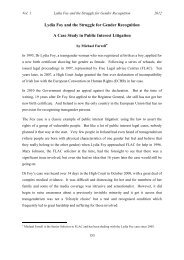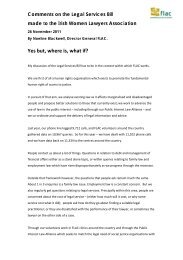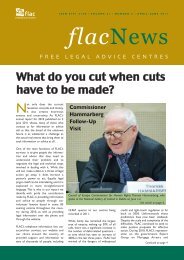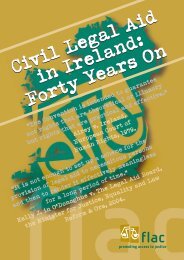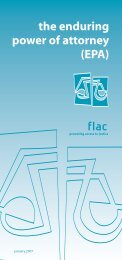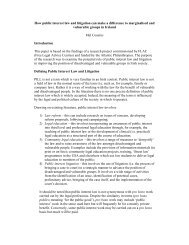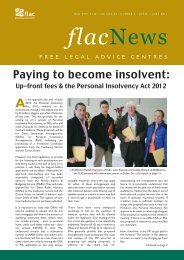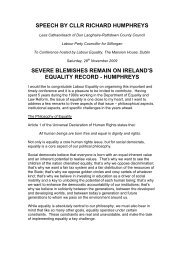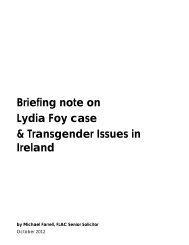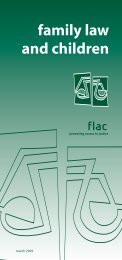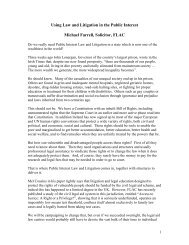Public Interest Litigation as a Tool for Vulnerable Groups: Lessons ...
Public Interest Litigation as a Tool for Vulnerable Groups: Lessons ...
Public Interest Litigation as a Tool for Vulnerable Groups: Lessons ...
Create successful ePaper yourself
Turn your PDF publications into a flip-book with our unique Google optimized e-Paper software.
PIL6 – <strong>Public</strong> <strong>Interest</strong> <strong>Litigation</strong> <strong>as</strong> a <strong>Tool</strong> <strong>for</strong> <strong>Vulnerable</strong> <strong>Groups</strong>: <strong>Lessons</strong> from India____________________________________________________________________________________________PIL6<strong>Public</strong> <strong>Interest</strong> <strong>Litigation</strong><strong>as</strong> a <strong>Tool</strong> <strong>for</strong><strong>Vulnerable</strong> <strong>Groups</strong>:<strong>Lessons</strong> from IndiaDr. Joshua C<strong>as</strong>tellino,Irish Centre <strong>for</strong> Human Rights, NUI GalwayFLAC <strong>Public</strong> <strong>Interest</strong> Law Seminar SeriesSeminar 3: 16 June 2006: Structures <strong>for</strong> <strong>Public</strong> <strong>Interest</strong> Lawand <strong>Litigation</strong> in Ireland
PIL6 – <strong>Public</strong> <strong>Interest</strong> <strong>Litigation</strong> <strong>as</strong> a <strong>Tool</strong> <strong>for</strong> <strong>Vulnerable</strong> <strong>Groups</strong>: <strong>Lessons</strong> from India____________________________________________________________________________________________foundations of international human rights law by power struggles betweene<strong>as</strong>t and west that led to the creation of two separate covenants in 1966: theInternational Covenant on Civil and Political Rights, and the InternationalCovenant on Economic, Social and Cultural Rights. The development of thetwo separate streams of human rights law have followed different paths sincethen, with an overwhelming emph<strong>as</strong>is on the <strong>for</strong>mer while the latter wereconsidered <strong>as</strong>pirational standards, and received significantly less attentionfrom human rights lawyers. This paper challenges the view prominent in legalcircles in Ireland, that ‘rights’ are mainly civil and political, suggesting that thisis a remnant of the laissez faire politics inherited through colonialism. Instead,it exhorts the need <strong>for</strong> looking beyond traditional sources of legal models tocountries such <strong>as</strong> India and South Africa <strong>for</strong> finding workable mechanisms toaddress questions vis-à-vis the exclusion of segments of population fromaccessing the rights table.Drawing on jurisprudence of the Indian Supreme Court towards fulfilling thestated aims, this paper seeks to portray: <strong>Public</strong> <strong>Interest</strong> <strong>Litigation</strong> <strong>as</strong> a Remedy; <strong>Public</strong> <strong>Interest</strong> <strong>Litigation</strong> in Practice; Possible lessons that could be imbibed in the Irish context.It remains fundamentally important to stress the nature of the t<strong>as</strong>k facingvulnerable groups the world over. Mired in conditions of extreme poverty,several southern states in building human rights regimes, have emph<strong>as</strong>isedthe need <strong>for</strong> these regimes to take due cognisance of economic, social andcultural rights. Aside from the morality that demands adequate attention bepaid to the plight of all sections of the population in a bid to improve theirinherent dignity and worth, a failure to attend to socio-economic rightsnegates any sophisticated regime of civil and political rights that maydevelop: since this remains inaccessible to many. According to the UnitedNations Development Programme, we live in a world where:… a fifth of the developing world’s population goes hungry every night, aquarter lacks access to even a b<strong>as</strong>ic necessary like safe drinking water, and athird lives in a state of abject poverty – at such a margin of human existencethat words simply fail to describe it, the importance of renewed attention andcommitment to the full realization of economic, social and cultural rights isself-evident….The report stresses that:…over one billion people live in circumstances of extreme poverty,homelessness, hunger and malnutrition, unemployment, illiteracy and chronicill-health. More than 1.5 billion people lack access to clean drinking water andsanitation, some 500 million children don’t have access to even primaryeducation; and more than one billion adults cannot read and write. Thism<strong>as</strong>sive scale of marginalization, in spite of continued global economicgrowth and development, raises questions, not only of development, but alsoof b<strong>as</strong>ic human rights. 4I. The Essentials of <strong>Public</strong> <strong>Interest</strong> <strong>Litigation</strong> <strong>as</strong> a Remedy: An IndianExtrapolation4 Fact Sheet No.16 (Rev.1) The Committee on Economic, Social and Cultural Rights
The cornerstone of remedies <strong>as</strong> provided <strong>for</strong> in the Indian Constitution isexpressed in the language of article 32, 5 which provides a right <strong>for</strong> citizens tomove the Supreme Court <strong>for</strong> any violations of their fundamental rights. 6 Thish<strong>as</strong> resulted in direct petitions to the apex court, and h<strong>as</strong> developed a strongsense of public interest litigation. 7 The relaxation of the rules of locus standiand the fact that there is no limitation on the relief the Courts can provide,h<strong>as</strong> facilitated remedies and procedures. 8 The activism of the Courts 9 h<strong>as</strong> alsoplayed a significant role in emph<strong>as</strong>ising this remedy further. 10 The essentials ofpublic interest litigation in India were summarized by Justice Bhagwati (sincethen a member of the UN Human Rights Committee) in S. P. Gupta:There must be a legal wrong caused to a person or to a determinate cl<strong>as</strong>s ofperson, on whom burden is imposed in violation of law or without legalauthority;The wrong must arise from violation of any constitutional or legal right;The wronged person (or determinate groups of persons) must be unable toapproach the court <strong>for</strong> relief, by re<strong>as</strong>on of –o poverty;oohelplessness; orsocial or economic disability of socially or economicallydisadvantageous position.If the above conditions are satisfactory, then any member of the public canseek judicial redress <strong>for</strong> the above wrong.But the court should be anxious to ensure that the person initiating theproceedings is acting bona fide to get redress <strong>for</strong> a public grievance and notto pursue any personal gain from malicious motives.5 As expressed in Daryao v State of UP AIR 1961 SC 1457, 1461 - fundamental rights are not only inplace to protect individual rights, but are also b<strong>as</strong>ed on public policy, and it w<strong>as</strong> the privilege and dutyof the Court to uphold those rights. The Court had already identified itself <strong>as</strong> the protector andguarantor of fundamental rights in Romesh Thappar v State of Madr<strong>as</strong> AIR 1950 SC 124.6 One of the most famous public interest c<strong>as</strong>es in India also shows the limit of using law from a‘minority’ perspective. In Narmada Bachao Andolan v Union of India, the displacement of population<strong>for</strong> the construction of the dam w<strong>as</strong> challenged. The Court held that the displacement did not violatefundamental rights; instead it analysed whether rehabilitation at newer locations made them better off,and satisfied itself that the new facilities were better than those enjoyed in the tribal hamlets, ruling thatgradual <strong>as</strong>similation into mainstream society would lead to betterment and progress see AIR 2000 SC3751.7 For more on the scope of public interest litigation <strong>as</strong> enunciated by the Courts themselves see S. P.Gupta v Union of India, AIR 1982 SC 149, 194.8 Especially D. C. Wadhwa v State of Bihar, AIR 1987 SC 579, para 38 and Fertilizer Corporation vUnion of India, AIR 1981 SC 344.9 Commenting on the occ<strong>as</strong>ion of 50 th Anniversary of the Indian Supreme Court, Dr Adarsh SeinAnand, CJ stated: …[The Court] h<strong>as</strong>, intervened to protect democracy and the rule of law… guided bythe Latin boni judicis est ampliare jurisdictionem (law must keep pace with society to retain itsrelevance)… to create a civil society in which respect <strong>for</strong> human dignity is the corner-stone of it’sfunctioning, the Supreme Court h<strong>as</strong> zealously protected the human rights of individuals… In expandingthe ambit of the right to life and personal liberty, the Court h<strong>as</strong> evolved compensatory jurisprudence,implemented international conventions and treaties, and issued directions <strong>for</strong> environmental justice. Ith<strong>as</strong> given directions, and also prescribed guidelines <strong>for</strong> the en<strong>for</strong>cement and achievement of humanrights of various groups such <strong>as</strong> children, women, disabled, scheduled c<strong>as</strong>tes, scheduled tribes, bondedlabourers, minorities, and socially and economically backward cl<strong>as</strong>ses’, <strong>for</strong>eword in V Kusum (n 9above) vi.10 SP Sathe Judicial Activism and the Indian Supreme Court (2002).4
If the c<strong>as</strong>e is otherwise appropriate <strong>for</strong> public interest litigation then the courtcan act even on letters addressed to it. 11<strong>Public</strong> interest litigation in India 12 emerged in response to a need to makejudicial processes more accessible to disadvantaged sections of society, andto ensure adequate judicial protection of human rights. 13 Unlike in othersettings 14 in India such litigation h<strong>as</strong> been more concerned with conflict ratherthan dispute resolution, with courts playing a political role in securingconstitutionally guaranteed human rights entitlements to the m<strong>as</strong>ses that callupon it to play such a role. 15Leading constitutional commentator Sathe summarizes the nature of publicinterest litigation in India <strong>as</strong> being particularly useful in the following contexts: 16a) in genuine collective rather than individual disputes; 17b) where victims belong to vulnerable sections of society; 18c) where judicial law-making is necessary to prevent exploitation; 19d) where judicial intervention is necessary to safeguard democratic institutions;ande) where administrative decisions related to development jeopardize peoples’right to natural resources. 20A swathe of c<strong>as</strong>es have come be<strong>for</strong>e the courts, dominated by c<strong>as</strong>esconcerning minorities, Dalits (the <strong>for</strong>mer ‘untouchables’ of the Indian c<strong>as</strong>tesystem) working or living in vulnerable conditions, besides women andchildren facing multiple <strong>for</strong>ms of discrimination 21 . Dalits and Tribal peoples inparticular, <strong>as</strong> arguably the most vulnerable and diverse groups in Indiansociety, have gained significant rights by moving the Supreme Court, less <strong>as</strong>an ethnic identity-b<strong>as</strong>ed grouping, more <strong>as</strong> an occupational grouping such<strong>as</strong> that of labourers in the unorganized sector of the economy or of bondedlabourers. 2211 S. P. Gupta v President of India AIR 1982 SC 149: (1981) Supp. SCC 87.12 Baxi prefers the term ‘Social Action <strong>Litigation</strong>’, which he suggests better describes the c<strong>as</strong>es underthis heading; ‘Taking Suffering Seriously: Social Action in the Supreme Court of India’ in S Dhavanand S Khurshid (ed) Judges and the Judicial Power (1985) 289; also see Ahuja (1997) (n 164 above)xxxvi13 ibid xxxv.14 For a comparative albeit limited examination of me<strong>as</strong>ures of affirmative action see A Peters Women,Quot<strong>as</strong> and Constitutions: A Comparative Study of Affirmative Action <strong>for</strong> Women under American,German, European Community and International Law (1999).15 SP Sathe ‘Introduction’ in S Ahuja (1997) (n 164 above) xli-xlii.16 ibid xlii.17 eg Bonded labourers, under-trial prisoners, prison inmates etc. For obiter dicta on this issue seeBhagwati J in P. U. D. R. and ors v Union of India, AIR 1982 SC 1473 at 1476-7.18 eg Unorganized labour, women, children etc. As expressed by Justice Iyengar in Bar Council ofMahar<strong>as</strong>htra v M.V. Dabholkar, AIR 1975 SC 2092 at 2104.19 Laxmikant Pandey v India¸ AIR 1987 SC 232 (inter-country adoption); Vishaljit v India, AIR 1990SC 1412; (1990) 3 SCC 318 (education <strong>for</strong> children of prostitutes).20 R. L. and E. Kendra v UP, AIR 1985 SC 632.21 eg Brij Bala v State of HP and ors (1984) 2 SLR 408 (concerning discrimination in seeking training<strong>for</strong> job reserved <strong>for</strong> men).22 Another vulnerable group that consists mainly Dalits are slum dwellers in urban spaces. Ahuja(1997) (n 164 above) discusses c<strong>as</strong>es brought by several different groups in their favour, 335-408. Themost remarkable c<strong>as</strong>e on this score is Olga Tellis and ors v Bombay Municipal Corporation and ors,AIR 1986 SC 180.5
II. <strong>Public</strong> <strong>Interest</strong> <strong>Litigation</strong> in Practice: Some InsightsSangeeta Ahuja’s two volumes studying public interest litigation in India areworthy of detailed study <strong>for</strong> the range of c<strong>as</strong>es that have been addressedthrough this mechanism. In this section a few examples have been chosen toillustrate the manner in which the Courts have dealt with issues and tohighlight their outcome.In Hira Lal and anr v Zilla Parishad, Kanpur and ors, 23 a petition on behalf ofScheduled C<strong>as</strong>tes employed in the fraying of carc<strong>as</strong>ses, resulted in a sociolegalinvestigation into the industry and finally suggestions from the Court tothe state government towards an improvement of the socio-economic plightof the workers in the industry. Similarly in Sanjit Roy v State of Raj<strong>as</strong>than 24exceptions to minimum wage (affecting mainly SC/ST workers) designed bythe Raj<strong>as</strong>than Famine Relief Work Employees (Exemption from Labour Laws)Act 1964 were repealed.According to studies, 86.6 per cent of bonded labourers come from amongthe Dalit and Tribal population. 25 Several c<strong>as</strong>es concerning bonded labourhave come be<strong>for</strong>e the Supreme Court under the Bonded Labour System(Abolition) Act, 1976. 26 While a remedy <strong>for</strong> bonded labour w<strong>as</strong> provided in theAct, it w<strong>as</strong> not until social action groups challenged its occurrence that thelegislation began to take effect. Journalists and public service organisations,rather than the labourers (most of whom were unaware their situation w<strong>as</strong> inviolation of law) moved the Court to repeal this ‘structurally entrenchedproblem’.27 Several c<strong>as</strong>es on the issue have come be<strong>for</strong>e the courts, raisingthe possibility of dismantling this age-old phenomenon. 2823 1982 (1) SCALE 123 [545].24 AIR 1983 SC 328, the action taken by the Social Work and Research Centre, in Raj<strong>as</strong>than (anorganisation working <strong>for</strong> the upliftment of SC/ST) complained against the <strong>Public</strong> Works Department’sviolation of the provisions of the Minimum Wages Act, 1948.25 Scheduled C<strong>as</strong>tes account <strong>for</strong> 61.5 percent while Scheduled Tribes account <strong>for</strong> 25.1 per cent of thetotal bonded labourers. See Ahuja (1997) (n 164 above) 300.26 s2(g) defines bonded labour <strong>as</strong> being in existence when the following conditions are satisfied: (i) inconsideration of an advance obtained by him or by any of his lineal descendants (whether or not suchadvance is evidenced by any document) and in consideration of the interest, if any, due on suchadvance or (ii) in pursuance of any customary social obligation, or (iii) in pursuance of an obligationdevolving on him by succession, or (iv) <strong>for</strong> any economic consideration received by him or by any ofhis lineal <strong>as</strong>cendants or descendants, or (v) by re<strong>as</strong>on of his birth in any particular c<strong>as</strong>te of community,he would – (1) render, by himself, or through any member of his family, or any person dependent onhim, labour or service to the creditor, <strong>for</strong> a specified period or <strong>for</strong> an unspecified period, either throughwages or <strong>for</strong> nominal wages, or; (2) <strong>for</strong>feit the freedom of employment or other means of livelihood <strong>for</strong>a specified period or <strong>for</strong> an unspecified period, or; (3) <strong>for</strong>feit the right to move freely throughout theterritory of India, or (4) <strong>for</strong>feit the right to appropriate or sell at market value any of his property orproduct of his labour or the labour of a member of his family or any person dependent upon him.27 Ahuja (1997) (n 164 above) 300.28 Bandhua Mukti Morcha v State of Tamil Nadu, 1986 (Supp) SCC 541; Bandhua Mukti Morcha vUnion of India and ors (Haryana Mines I), AIR 1984 SC 802/(1984) 4 SCC 161, 1991 (1) SCALE 79[295], AIR 1992 SC 38; Bandhua Mukti Morcha, through Chairman, Swami Agnivesh v State ofHaryana and ors (Haryana Mines II), 1983 (1) SCALE 121 [543]; Vivek Pandit v State of Mahar<strong>as</strong>htraWP No. 1503 of 1984; Vivek Pandit v State of Makar<strong>as</strong>htra WP No. 1504 of 1984; ChattisgarhKrishak Mazdoor Sangh v State of MP and others WP No. 13300 of 1983; Upendra and ors v State ofMP and anr WP (Civil/Cri) No 1071 of 1986 among others.6
considered in Maharishi Avadesh v Union of India, 37 where a petition seekinga writ of mandamus against the Government <strong>for</strong> the introduction of acommon civil code w<strong>as</strong> dismissed on the grounds that this w<strong>as</strong> an issue <strong>for</strong>the legislature and the court had no mandate in such matters. 38 A similar limitin the courts’ ambit w<strong>as</strong> revealed in dismissing a petition seeking to strikedown section 10 of the Indian Divorce Act 1869 (applicable to Christians)which it w<strong>as</strong> claimed, discriminated between men and women. 39An authoritative pronouncement on the issue w<strong>as</strong> made in Pannalal BansilalPatil v State of Andhra Pradesh 40 where the Court stated that while a uni<strong>for</strong>mcivil code <strong>for</strong> all of India may be desirable, its enactment may becounterproductive to national unity. 41 Mindful of ‘pluralist’ nature of Indiansociety, and the diversity in faith, belief systems and language, the Courtwarned:In a democracy governed by the rule of law, gradual progressive changeand order should be brought about. Making law or amendment to a law is <strong>as</strong>low process and the legislature attempts to remedy where the need is feltmost acute. It would, there<strong>for</strong>e, be inexpedient and incorrect to think that alllaws have to be made uni<strong>for</strong>mly applicable to all peoples in one go. Themischief of defect which is most acute can be remedied by process of law atstages. 42III. Specific Features that Contributed to Development of PIL in IndiaThe Indian example is a particularly appropriate one in the Irish context <strong>for</strong> anumber of re<strong>as</strong>ons: (1) India is a common law country whose legal systembears close resemblance to the Irish legal system (2) Like Ireland, India w<strong>as</strong> acolony of Britain and to that extent, the similarities in its institutions stems fromthat commonality. (3) India provides an apt comparison to Ireland since theIndian Constitution h<strong>as</strong> been influenced by the Irish Constitution and containsprovisions such <strong>as</strong> the dual language issue and the notion of directiveprinciples borrowed from the Irish Constitution.The enormity of the t<strong>as</strong>k facing the creation of a Constitution in India w<strong>as</strong>effectively captured in the words of Dr. B.R. Ambedkar the chief architect ofthe Indian Constitution:On the 26th of January 1950, we are going to enter into a life ofcontradictions. In politics we will have equality and in social and economic lifewe will have inequality. In politics we will be recognizing the principle of oneman one vote and one vote one value. In our social and economic life, weshall, by re<strong>as</strong>on of our social and economic structure, continue to deny the37 (1994) 1 Supp SCC 713.38 The petition also requested an order nullifying the Muslim Women’s Protection of Rights on DivorceAct 1986, also declined, <strong>as</strong> w<strong>as</strong> the request to direct the Government not to enact a Shariat Act, on thegrounds that it would affect the rights of Muslim women.39 Reynold Rajamani v Union of India, AIR 1982 SC 1261, 1263, 1264.40 AIR 1996 SC 1023 para.12.41 The context of that particular c<strong>as</strong>e w<strong>as</strong> <strong>for</strong> the extension of the Andhra Pradesh Hindu Religious andCharitable Endowments Act, 1987 to persons professing a variety of religions rather than it beingapplicable solely to Hindus. As cited in Bakshi (n 84 above) 89.42 Pannalal Bansilal v State of Andhra Pradesh, AIR 1996 SCW 507, 515: (1996) 2 SCC 4988
principle of one man one value. How long shall we continue to live this life ofcontradictions? 43This statement is augmented in that law had traditionally been viewed <strong>as</strong> acolonial imposition, used by a tiny proportion of the Indian population duringthe British era. In the words of Bhagwati these were, unsurprisingly:…the affluent… who were repeat players of the litigation game. The poorhaving been priced out of the judicial system. 44As mentioned above, two specific provisions of the Constitution are worthhighlighting since they are arguably the engine room <strong>for</strong> the development ofpublic interest litigation in the sphere of economic social and cultural rights.Article 32 (a)The right to move the Supreme Court by appropriate proceedings <strong>for</strong> theen<strong>for</strong>cement of the rights conferred by [Part III of the Constitution, containingfundamental rights] is guaranteed.Article 226:Every High Court shall have the power … to issue any person, or authorityincluding in appropriate c<strong>as</strong>es any Government … directions, orders or writs,including writs in the nature of 45 habe<strong>as</strong> corpus, mandamus, prohibition, quowarranto and certiorari, or any of them, <strong>for</strong> the en<strong>for</strong>cement of any of therights conferred by Part III and <strong>for</strong> any other purpose. 46There are several technical features of these articles that make themparticularly amenable to public interest litigation: Article 32 makes the Court accessible <strong>for</strong> a wide variety ofen<strong>for</strong>cement of fundamental rights; The range of remedies available to the court is wide enough <strong>for</strong> theCourt to consider an array of remedies; The range of remedies available, including stay orders and injunctions,h<strong>as</strong> given the Court considerable el<strong>as</strong>ticity in using private lawremedies in the discharge of public law functions; Where public interest is involved the Courts have been slow to rejectan application on the grounds of delay. 47In commenting on the manner in which the Indian courts have interpretedthe provisions of the two articles Sathe, a leading commentator on thejudicial activism of the courts points out:…the court developed a new paradigm of judicial process consistent with therights discourse it h<strong>as</strong> generated through judicial activism. The new paradigmenvisions an affirmative, proactive role of the Court <strong>for</strong> facilitating access tojustice <strong>for</strong> those who did not possess either the know-how or the resources <strong>for</strong>invoking the judicial process on their behalf and <strong>for</strong> ensuring greater public43 Constituent Assembly Debates Vol.12 p.979 25 th November, 1949 (Government of India)44 Bhagwati 1987 p.2445 The use of the term ‘in the nature of’ w<strong>as</strong> further testimony to the use friendliness of theConstitution. In T.C. B<strong>as</strong>appa v T. Nagappa AIR 1954 SC 440 it w<strong>as</strong> held that the Court would notstand on the <strong>for</strong>mality of the request prayed <strong>for</strong>, instead if a violation w<strong>as</strong> established the Court wouldissue an appropriate remedy. Thus <strong>for</strong>m would not defeat substance.46 ‘<strong>for</strong> any other purpose’ w<strong>as</strong> deemed by the Supreme Court of India <strong>as</strong> meaning the en<strong>for</strong>cement ofany statutory <strong>as</strong> well <strong>as</strong> common law right. See Calcutta G<strong>as</strong> Co. v State of West Bengal AIR 1962 SC1044 (1963) 1 SCJ 10647 Dr. K<strong>as</strong>hinath G. Jalani v the Speaker (1993) 2 SCC 7039
participation in the judicial umpiring of the constitutional government. Thenew paradigm w<strong>as</strong> <strong>for</strong> a court that had to protect the rights of the poor andilliterate people of Indian and to ensure that the rule of law w<strong>as</strong> observed bycitizens <strong>as</strong> well <strong>as</strong> rulers.This doctrinal activism of the Court w<strong>as</strong> actively supported by procedural andsubstantive changes, nonetheless still respecting the doctrine ofparliamentary sovereignty i.e. still maintaining the nature of the Courts <strong>as</strong>upholders of Parliamentary will, but relying heavily on the Constitution tointerpret this will. 48 This activism w<strong>as</strong> undertaken <strong>for</strong> three primary objectives:(a) For bringing the redressal of grievances of the victimized sections ofsociety within the purview of the Court; (b) In addressing proceduralinnovations with a view to making justice less <strong>for</strong>mal, cheaper and moreexpedient, and (c) For making the judicial process more participatory,polycentric, and result oriented. 49IV. Ireland, <strong>Public</strong> <strong>Interest</strong> <strong>Litigation</strong> and the Justiciability QuestionWithout a doubt the central issue on the nature of economic, social andcultural rights revolves around whether they are ‘justiciable’ i.e. whetherremedies can be sought from a Court <strong>for</strong> law in c<strong>as</strong>es where violations haveoccurred. The example of the Indian Supreme Court h<strong>as</strong> highlighted above,when supplemented by examples from jurisdictions such <strong>as</strong> South Africa,Australia, the United States of America and New Zealand suggest that thequestion can be answered with some certainty.Minister of Justice, Equality & Law Re<strong>for</strong>m Minister Michael McDowell is agood exponent of one who argues against the justiciability of economic,social and cultural rights. In a speech given on the theme of Irish Culture andthe Law at St. Patrick’s College in Drumcondra in April 2003 he observed:The p<strong>as</strong>t few decades too have seen a tension develop between those whoadvocate, on one side, that the fundamental law of the State, ourConstitution, should contain a justiciable corpus of rights relating to economicand social issues, and those on the other, who question the desirability orindeed, necessity <strong>for</strong> such a course of action. I am in firmly in the lattercamp. 50He gleans support <strong>for</strong> this position from the Constitution of the State and in thiscontext states:..most of what are called ‘economic and social rights’, with the notableexception of the right to free primary education, cannot be en<strong>for</strong>ced in theCourts. In article 45, the Constitution sets out ‘Directive Principles of SocialPolicy’ which are intended <strong>for</strong> the general guidance of the Oireacht<strong>as</strong>. TheConstitution states that application of those principles in the making of lawsshall be the care of the Oireacht<strong>as</strong> exclusively, and shall not be ‘cognisableby any Court under any of the provisions of the Constitution’. In other words itis not open to anyone to seek a direction from the Courts to secure the48 For a detailed reading of the history of the Supreme Court, especially in the context of itsrelationship with the executive see Verma, SK and Kusum, Kumar (eds.), Fifty Years of the SupremeCourt of India: Its Gr<strong>as</strong>p and Reach (New Delhi: Indian Law Institute, Ox<strong>for</strong>d University Press, 2000).49 Sathe S.P. Judicial Activism in India: Transgressing Borders and En<strong>for</strong>cing limits (Ox<strong>for</strong>d: Ox<strong>for</strong>dUniversity Press, 2002) p.20150 Transcript on file with author.10
implementation of any of those principles. It is thus argued by many peoplethat economic and social rights, such <strong>as</strong> those identified in the ICESCR, shouldbe incorporated in the Constitution in such a way that an individual couldseek from the Courts redress if his or her rights under the Covenant had notbeen met. It is argued that unless these rights are justiciable, they are noteffective. 51He also <strong>as</strong>ks whether the Courts are the correct bodies to adjudicate onthese issues:There is an important political and philosophical question yet to be answeredsatisfactorily; that is whether the protection and achievement of policy valuesin the social and economic sphere is property <strong>for</strong> the legislative and executivearms of the State or <strong>for</strong> en<strong>for</strong>cement through the judicial system… I, <strong>for</strong> mypart, believe p<strong>as</strong>sionately in politics <strong>as</strong> the means <strong>for</strong> conducting andresolving social and economic issues. 52A further rationale given <strong>for</strong> this position is the belief that ‘cl<strong>as</strong>sical civil andpolitical rights’ are ‘public goods’ while economic and social rights are‘private goods’. 53 Thus the suggestion is that while it is appropriate that theCourts c<strong>as</strong>t judgement on the first he suggests that the latter are in his view‘the stuff of politics and not at all appropriate to be decided by the Courts.The problem with the suggestion of ‘politics’ <strong>as</strong> a means <strong>for</strong> conducting andresolving social and economic issues’ comes down squarely to the questionof uneven access to politics.<strong>Vulnerable</strong> groups, by virtue of their position in society are severelydisadvantaged in accessing politics, in very many instances being <strong>for</strong>ced tobe concerned with day-to-day survival rather with long-term strategicpolitical involvement. If constitutionally guaranteed fruits are denied to themby virtue of their socio-economic position, this would create an obligationupon states to pay attention to their empowerment. Since a major factor inindigence is the lack of resources it is hard to understand how the ‘politicalrealm’ can be engaged without the largesse and generosity of majoritypopulation. This would make access to constitutional guarantees a questionor charity rather than one rights.The non-justiciability argument is also challenged by the Committee <strong>for</strong>Economic, Social and Cultural Rights (CESCR) the monitoring body <strong>for</strong> theInternational Covenant <strong>for</strong> Economic, Social and Cultural Rights (to whichIreland is bound), who often meet this argument. They make three tellingpoints in their general comment on the subject, drawing on the work of theInternational Law Commission which differentiates between ‘obligation ofconduct’ and ‘obligation of result’, suggesting that the paucity of dramaticresults in the realm of economic and social rights promotion could notabdicate the obligation of conduct by the State to guarantee and protectsuch rights. Just because the rights contained the Covenant are not framed<strong>as</strong> direct entitlements in the same way <strong>as</strong> civil and political rights are, doesnot means that there are no obligations on state parties. Thus while51 Ibid.52 Ibid.53 Against this see the various writings in the context of EU law <strong>as</strong> contained in Hervey T. & Kenner J.(eds.) Economic and Social Rights under the EU Charter of Fundamental Rights (Hart, 2003)11
ecognizing the difficulty of delivering economic and social rights, thecommittee nonetheless stresses that:… while the Covenant provides <strong>for</strong> progressive realization and acknowledgesthe constraints due to the limits of available resources, it also imposes variousobligations which are of immediate effect. Of these, two are of particularimportance in understanding the precise nature of States parties obligations.One of these, which is dealt with in a separate general comment, and whichis to be considered by the Committee at its sixth session, is the “undertaking toguarantee” that relevant rights “will be exercised without discrimination…” 54The other is the undertaking in article 2 (1) “to take steps”, which in itself, is notqualified or limited by other considerations. The full meaning of the phr<strong>as</strong>ecan also be gauged by noting some of the different language versions. InEnglish the undertaking is “to take steps”, in French it is “to act” (“s'engage àagir”) and in Spanish it is “to adopt me<strong>as</strong>ures” (“a adoptar medid<strong>as</strong>”). Thuswhile the full realization of the relevant rights may be achieved progressively,steps towards that goal must be taken within a re<strong>as</strong>onably short time after theCovenant’s entry into <strong>for</strong>ce <strong>for</strong> the States concerned. Such steps should bedeliberate, concrete and targeted <strong>as</strong> clearly <strong>as</strong> possible towards meeting theobligations recognized in the Covenant. 55A second issue emph<strong>as</strong>ized <strong>as</strong> being of great importance w<strong>as</strong> the need andimportance of judicial remedies:Among the me<strong>as</strong>ures which might be considered appropriate, in addition tolegislation, is the provision of judicial remedies with respect to rights whichmay, in accordance with the national legal system, be considered justiciable.The Committee notes, <strong>for</strong> example, that the enjoyment of the rightsrecognized, without discrimination, will often be appropriately promoted, inpart, through the provision of judicial or other effective remedies. Indeed,those States parties which are also parties to the International Covenant onCivil and Political Rights are already obligated (by virtue of arts. 2 (par<strong>as</strong>. 1and 3), 3 and 26) of that Covenant to ensure that any person whose rights orfreedoms (including the right to equality and non-discrimination) recognizedin that Covenant are violated, "shall have an effective remedy" (art. 2 (3) (a)).In addition, there are a number of other provisions in the InternationalCovenant on Economic, Social and Cultural Rights, including articles 3, 7 (a)(i), 8, 10 (3), 13 (2) (a), (3) and (4) and 15 (3) which would seem to be capableof immediate application by judicial and other organs in many national legalsystems. Any suggestion that the provisions indicated are inherently non-selfexecutingwould seem to be difficult to sustain. 56Finally, with regards to resources, the Committee stressed the importance ofcreating an atmosphere where economic and social rights can thrive:…The Committee wishes to emph<strong>as</strong>ize, however, that even where theavailable resources are demonstrably inadequate, the obligation remains <strong>for</strong>a State party to strive to ensure the widest possible enjoyment of the relevantrights under the prevailing circumstances. 5754 UNCESCR General Comment 3 entitled “The Nature of States Parties Obligations (Article 2paragraph 1) 14/12/90 fifth session, paragraph 1.55 Ibid. paragraph 256 Ibid. paragraph 557 Ibid. paragraph 1112
In any c<strong>as</strong>e this latter option is not relevant to a f<strong>as</strong>t-expanding state such <strong>as</strong>Ireland which regularly reports incre<strong>as</strong>es in tax revenues.ConclusionIn the final analysis this paper seeks to make the following points: The utility and value of public interest litigation is growing all over theworld, especially in contexts where civil societies are active. This isbecause groups and their advocates have realised that many of theviolations of their rights are due to structural deficiencies that result inpersistent and institutionalised discrimination that cannot always beaddressed adequately on an individual b<strong>as</strong>is. Among the technical adjustments required in law to enable publicinterest litigation to be more fe<strong>as</strong>ible are the following: (a) a SupremeCourt empowered with a range of remedies; (b) relatively unrestrictedrules vis-à-vis locus standi; (c) genuine belief in the Courts <strong>as</strong> providersof adequate remedies; (d) a progressive relationship between thecourts and the executive. <strong>Public</strong> <strong>Interest</strong> litigation is a vital tool <strong>for</strong> the furtherance of economicand social rights, with several examples of issues that have been raisedin this realm that highlight its utility in enunciating a coherent vision ofsuch rights. Further the obligation to put in place adequate judicialremedies <strong>for</strong> the furtherance of such rights would be ideally met by thedevelopment of legislation b<strong>as</strong>ed on public interest litigation.Finally it needs to be emph<strong>as</strong>ized that <strong>for</strong> a society that truly believes in theinherent dignity and worth of every individual human being, it is inconsistentto only focus on the civil and political rights of its citizens. By engaging andembracing the remedy of public interest litigation, societies can take animportant step towards realising their own constitutionally enshrined rights,and providing their citizens with the indivisible fruits of economic, social,cultural, civil and political rights.13



